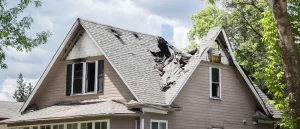Storms are a natural part of life, but when they strike, the damage they leave behind can be devastating. From uprooted trees to flooded basements and damaged roofs, storm damage can affect homes, vehicles, businesses, and even entire communities. Understanding what storm damage is, how it happens, and what to do afterward is essential for staying safe and prepared.
What Causes Storm Damage?
Storm damage is caused by extreme weather events, including:
- Strong winds
- Heavy rain and flooding
- Lightning strikes
- Hailstorms
- Snow and ice storms
- Tornadoes and hurricanes
These elements can strike suddenly, leaving little time to react — which is why preparation is key.
Types of Storm Damage
Here are the most common types of storm-related damage:
1. Wind Damage
High winds can tear off shingles, break windows, and knock down trees or power lines. In severe cases, entire structures can be damaged or destroyed.
2. Water Damage
Rainwater can leak into roofs, basements, and walls, causing mold, rot, and structural problems. Flooding can be especially dangerous and costly.
3. Hail Damage
Hailstones can dent cars, crack windows, and damage roofing materials, especially if they are large and fall at high speeds.
4. Lightning Damage
Lightning can strike trees, power poles, or buildings, causing fires, power outages, and electrical damage.
5. Snow and Ice Damage
Snow buildup can collapse roofs, while ice can weigh down trees and power lines or cause slippery and dangerous conditions.
How to Prepare for Storms
Preparing in advance can reduce the risk of damage. Here are a few tips:
- Secure loose outdoor items like patio furniture and trash cans.
- Trim trees and branches near your home.
- Check your roof and gutters regularly.
- Have an emergency kit with flashlights, food, water, and a first-aid kit.
- Know your evacuation routes if you live in a high-risk area.
What to Do After a Storm
If a storm has passed and caused damage:
- Stay safe – Watch for downed wires, broken glass, and flooded areas.
- Document the damage – Take photos or videos of all affected areas.
- Call your insurance company – Report the damage and begin the claims process.
- Make temporary repairs – Cover broken windows or roof leaks to prevent further damage.
- Hire professionals – Use licensed contractors to assess and repair structural issues.
Conclusion
Storm damage can happen quickly and unexpectedly, but being informed and prepared makes all the difference. Whether it’s securing your home before a storm or knowing what steps to take after one hits, having a plan can help protect both your property and your peace of mind.




